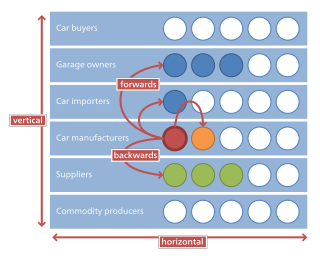
Mergers and acquisitions (M&A) are business transactions in which the ownership of companies, business organizations, or their operating units are transferred to or consolidated with another company or business organization. This could happen through direct absorption, a merger, a tender offer or a hostile takeover. As an aspect of strategic management, M&A can allow enterprises to grow or downsize, and change the nature of their business or competitive position.

Sales are activities related to selling or the number of goods sold in a given targeted time period. The delivery of a service for a cost is also considered a sale. A period during which goods are sold for a reduced price may also be referred to as a "sale".

Horizontal integration is the process of a company increasing production of goods or services at the same level of the value chain, in the same industry. A company may do this via internal expansion or through mergers and acquisitions.
New product development (NPD) or product development in business and engineering covers the complete process of launching a new product to the market. Product development also includes the renewal of an existing product and introducing a product into a new market. A central aspect of NPD is product design. New product development is the realization of a market opportunity by making a product available for purchase. The products developed by an commercial organisation provide the means to generate income.
In the field of management, strategic management involves the formulation and implementation of the major goals and initiatives taken by an organization's managers on behalf of stakeholders, based on consideration of resources and an assessment of the internal and external environments in which the organization operates. Strategic management provides overall direction to an enterprise and involves specifying the organization's objectives, developing policies and plans to achieve those objectives, and then allocating resources to implement the plans. Academics and practicing managers have developed numerous models and frameworks to assist in strategic decision-making in the context of complex environments and competitive dynamics. Strategic management is not static in nature; the models can include a feedback loop to monitor execution and to inform the next round of planning.
Marketing management is the strategic organizational discipline that focuses on the practical application of marketing orientation, techniques and methods inside enterprises and organizations and on the management of marketing resources and activities. Compare marketology, which Aghazadeh defines in terms of "recognizing, generating and disseminating market insight to ensure better market-related decisions".
In business, a competitive advantage is an attribute that allows an organization to outperform its competitors.
Marketing strategy refers to efforts undertaken by an organization to increase its sales and achieve competitive advantage. In other words, it is the method of advertising a company's products to the public through an established plan through the meticulous planning and organization of ideas, data, and information.

Rebranding is a marketing strategy in which a new name, term, symbol, design, concept or combination thereof is created for an established brand with the intention of developing a new, differentiated identity in the minds of consumers, investors, competitors, and other stakeholders. Often, this involves radical changes to a brand's logo, name, legal names, image, marketing strategy, and advertising themes. Such changes typically aim to reposition the brand/company, occasionally to distance itself from negative connotations of the previous branding, or to move the brand upmarket; they may also communicate a new message a new board of directors wishes to communicate.
A strategic alliance is an agreement between two or more parties to pursue a set of agreed upon objectives needed while remaining independent organizations.
Business development entails tasks and processes to develop and implement growth opportunities within and between organizations. It is a subset of the fields of business, commerce and organizational theory. Business development is the creation of long-term value for an organization from customers, markets, and relationships. Business development can be taken to mean any activity by either a small or large organization, non-profit or for-profit enterprise which serves the purpose of 'developing' the business in some way. In addition, business development activities can be done internally or externally by a business development consultant. External business development can be facilitated through Planning Systems, which are put in place by governments to help small businesses. In addition, reputation building has also proven to help facilitate business development.
The following outline is provided as an overview of and topical guide to business management:
Diversification is a corporate strategy to enter into or start new products or product lines, new services or new markets, involving substantially different skills, technology and knowledge.

The following outline is provided as an overview of and topical guide to marketing:
A target market, also known as serviceable obtainable market (SOM), is a group of customers within a business's serviceable available market at which a business aims its marketing efforts and resources. A target market is a subset of the total market for a product or service.
A chief strategy officer (CSO) is an executive that usually reports to the CEO and has primary responsibility for strategy formulation and management, including developing the corporate vision and strategy, overseeing strategic planning, and leading strategic initiatives, including M&A, transformation, partnerships, and cost reduction. Some companies give the title of chief strategist or chief business officer to its senior executives who are holding the top strategy role.
Corporate venture capital (CVC) is the investment of corporate funds directly in external startup companies. CVC is defined by the Business Dictionary as the "practice where a large firm takes an equity stake in a small but innovative or specialist firm, to which it may also provide management and marketing expertise; the objective is to gain a specific competitive advantage." Examples of CVCs include GV and Intel Capital.
EPG Model is an international business model including three dimensions – ethnocentric, polycentric and geocentric. It has been introduced by Howard V. Perlmutter within the journal article "The Tortuous Evolution of Multinational Enterprises" in 1969. These three dimensions allow executives to more accurately develop their firm's general strategic profile.
Product strategy defines the high-level plan for developing and marketing a product, how the product supports the business strategy and goals, and is brought to life through product roadmaps. A product strategy describes a vision of the future with this product, the ideal customer profile and market to serve, go-to-market and positioning (marketing), thematic areas of investment, and measures of success. A product strategy sets the direction for new product development. Companies utilize the product strategy in strategic planning and marketing to set the direction of the company's activities. The product strategy is composed of a variety of sequential processes in order for the vision to be effectively achieved. The strategy must be clear in terms of the target customer and market of the product in order to plan the roadmap needed to achieve strategic goals and give customers better value.




